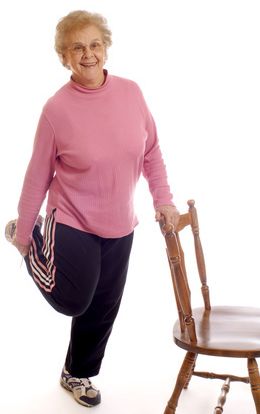
As the weather turns cold, we have a natural tendency to hibernate and neglect our need for exercise. Generally, developing fitness plans focuses on the young and middle-aged and forget that seniors need fitness routines of their own that take into account their special needs and deficits.
FACT: By 2030, 1 in 5 Americans will be older than 65.
As people age, there is a loss of muscle mass, strength, flexibility and bone leading to a loss of mobility and, therefore, independence. Regular exercise including aerobics, strength training as well as balance and flexibility exercises can mitigate this.
FACT: New studies show that a well-designed exercise plan can delay or prevent loss of cognitive functioning until the 90’s and longer. Now that’s motivation!
In recent studies, older adults who participated in a moderate exercise program were able to increase the thickness of their brain’s cortex, the part of the brain that usually atrophies with Alzheimer’s disease. Both healthy, older adults and those already diagnosed with mild cognitive impairment (MCI) benefitted. In fact, those already with MCI showed the greatest improvement with significant improvement in memory recall.
MYTH: The elderly feel it’s too late to make significant improvements in their overall health.
Actually, strengthening muscles and improving flexibility, balance and bone density is the most beneficial thing you can do to prevent injuries and dreaded elderly falls. Now is precisely the time to work on these deficits.
MYTH: Seniors can’t exercise because they are too frail and will hurt themselves.
An exercise regimen incorporating goals specific to the elderly client while taking into account their specific deficits is best accomplished using a fitness trainer who is acquainted with the elderly and their special needs and know how much to push them for improved strength, flexibility and mobility. Just make sure all exercises are approved by a medical and healthcare team and all should be good to go!
Start Slowly.....
If someone hasn’t exercised in awhile, start slowly with shorter, more frequent periods of exercise. Basically, you need about 30 minutes of exercise per day which can be broken into two 15 minute or three 10 minute intervals. Varying the exercises improves different areas and adds interest. Employing a trainer for at least the first few sessions will help ensure that exercises are being done correctly.
Activities should include some appropriate aerobic or cardiovascular work through activities. Strength training is great for enhancing balance to reduce the risk of falls and to help in general with getting up and down. Yoga is a wonderful and relaxing form of exercise as is Tai Chi. For those who are able to get out, strength training can also be done using machines in a gym calibrated to the individual.
Follow these steps in conjunction with professionals and the senior will be well on the way to a healthier, fitter self.
1. Assess the current physical condition of the senior.
a) Start informally with the senior and a relative or caregiver.
b) After, go over it more formally with the primary doctor and professional trainer.
2. Design a specific exercise routine based on the senior’s deficits and preferences. Include a variety of exercises and activities like:
a) Sitting and standing exercises.
b) Water exercise such as swimming.
c) Outdoor activities such as brisk walking or gardening.
d) Exercises for balance like yoga or tai chi.
3. Establish the routine to ensure a solid pattern is set and make available videos or apps on a phone or tablet for learning, reinforcement and proper form.
4. Find exercise buddies or a class. Companionship makes it more enjoyable and is insurance that the new regimen will be adhered to.
5. Cheer on your senior and laud this important accomplishment.
Resources
There are many resources for helping seniors incorporate their new routine into everyday life. The National Institutes of Health Go4Life website has excellent exercise tips and videos. David York Home Healthcare Agency has a packet of worksheets, “My Exercise Plan”, available at their website to be used in association with healthcare professionals and fitness trainers experienced in dealing with the elderly. The plan helps organize:
- Short and long term physical fitness goals.
- Specific workout activities addressing: increased mobility; endurance; upper-body strength; lower-body strength; balance, and flexibility.
- Number of minutes and times per week for each exercise with a monthly view of the workout routine and the tracking of daily and weekly adherence with a log and progress notes.
We now know that exercise isn’t just great for your body, but also your mind. Seniors who exercise daily improve physically and maintain cognitive health. Be patient and remember it’s never too late to begin exercising since every movement optimizes vitality. Let me know if I can help!
Anita Kamiel, R.N, M.P.S. is the founder and owner of David York Home Healthcare Agency and is fully acquainted with all factors related to eldercare services and the latest guidelines for seniors. Thirty years ago, she realized the need for affordable, quality home health aide services provided and supervised by caring individuals. You can contact her at 718.376.7755 or at info@davidyorkagency.com. David York Agency is also on Facebook, Twitter, Google+ and LinkedIn.
